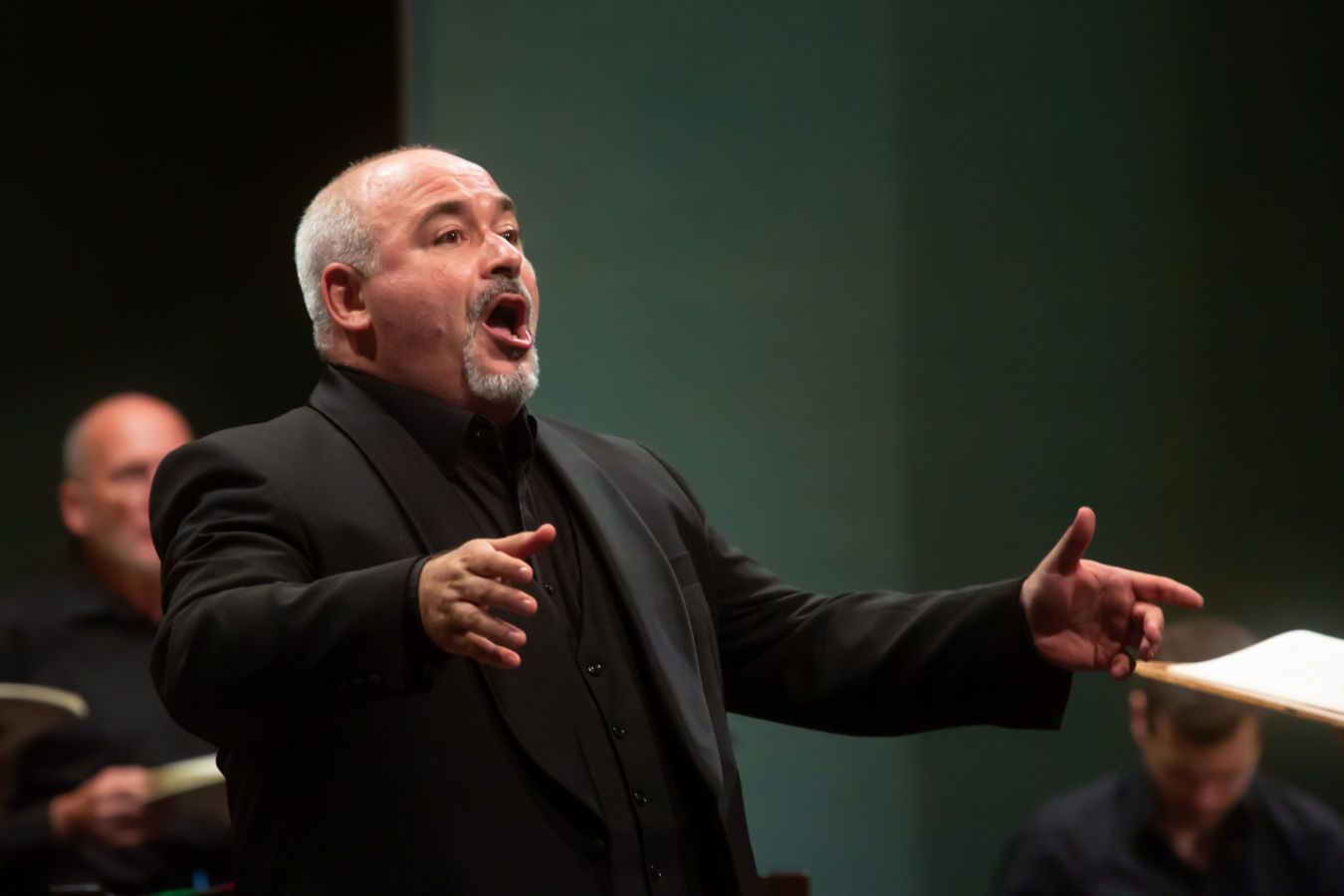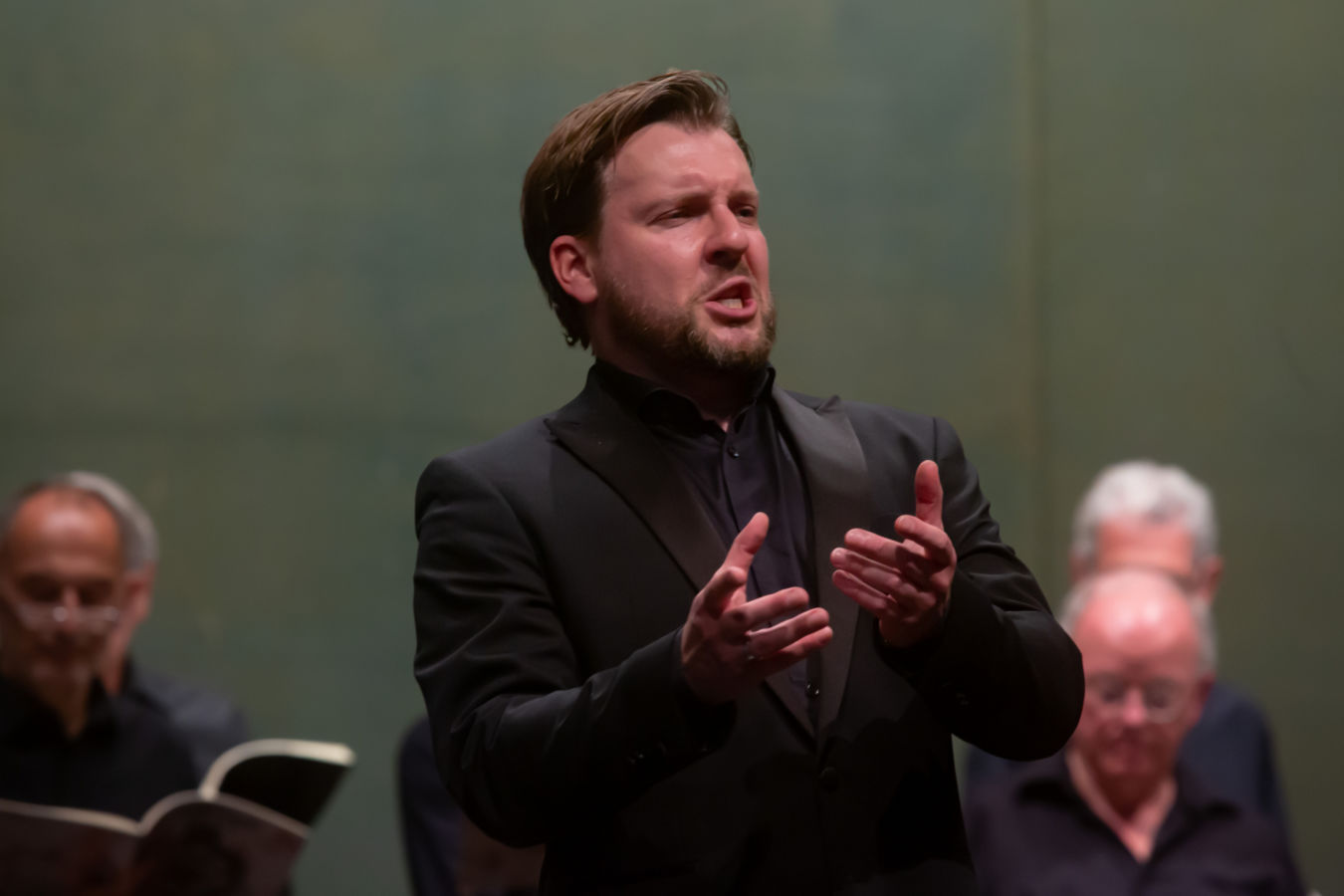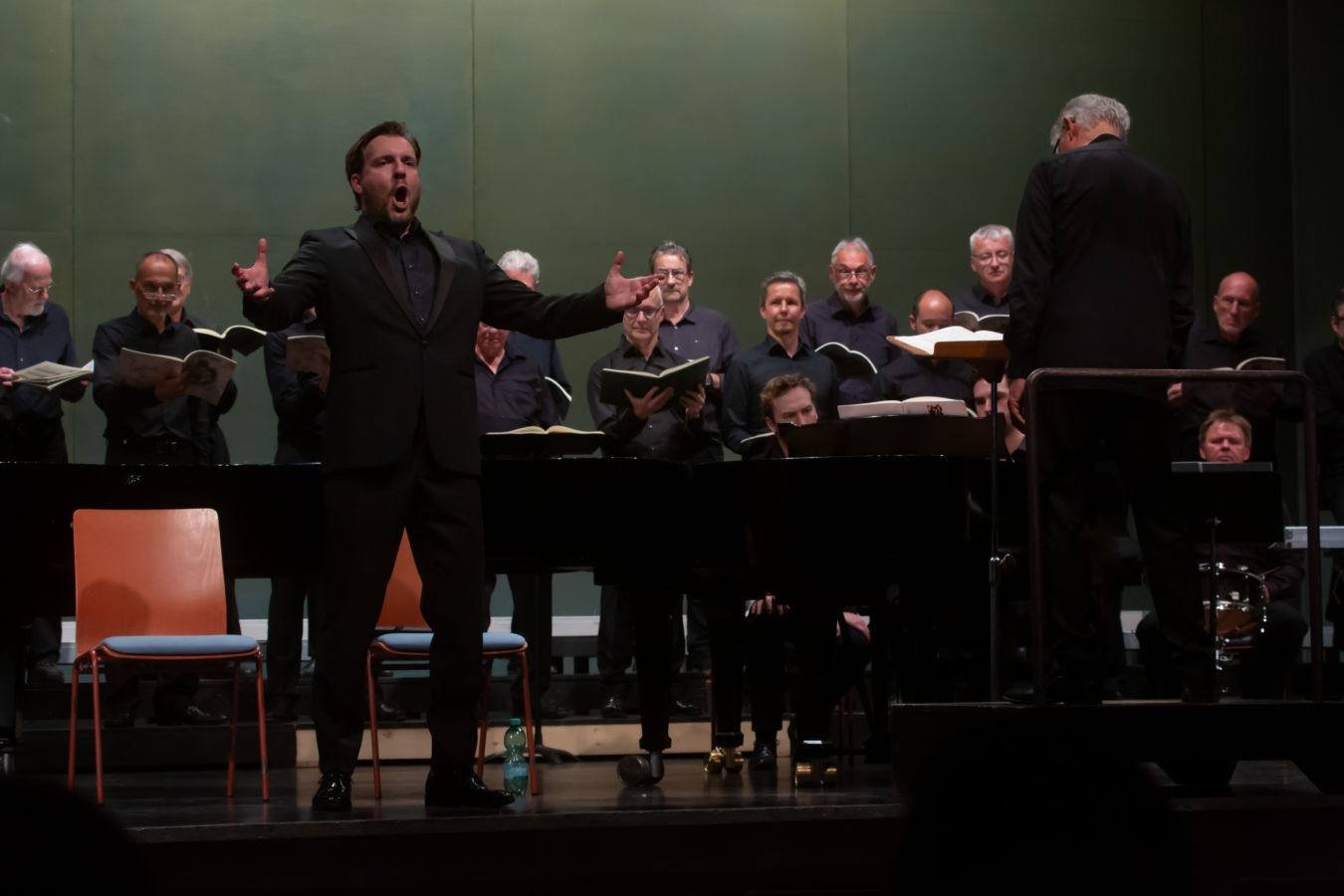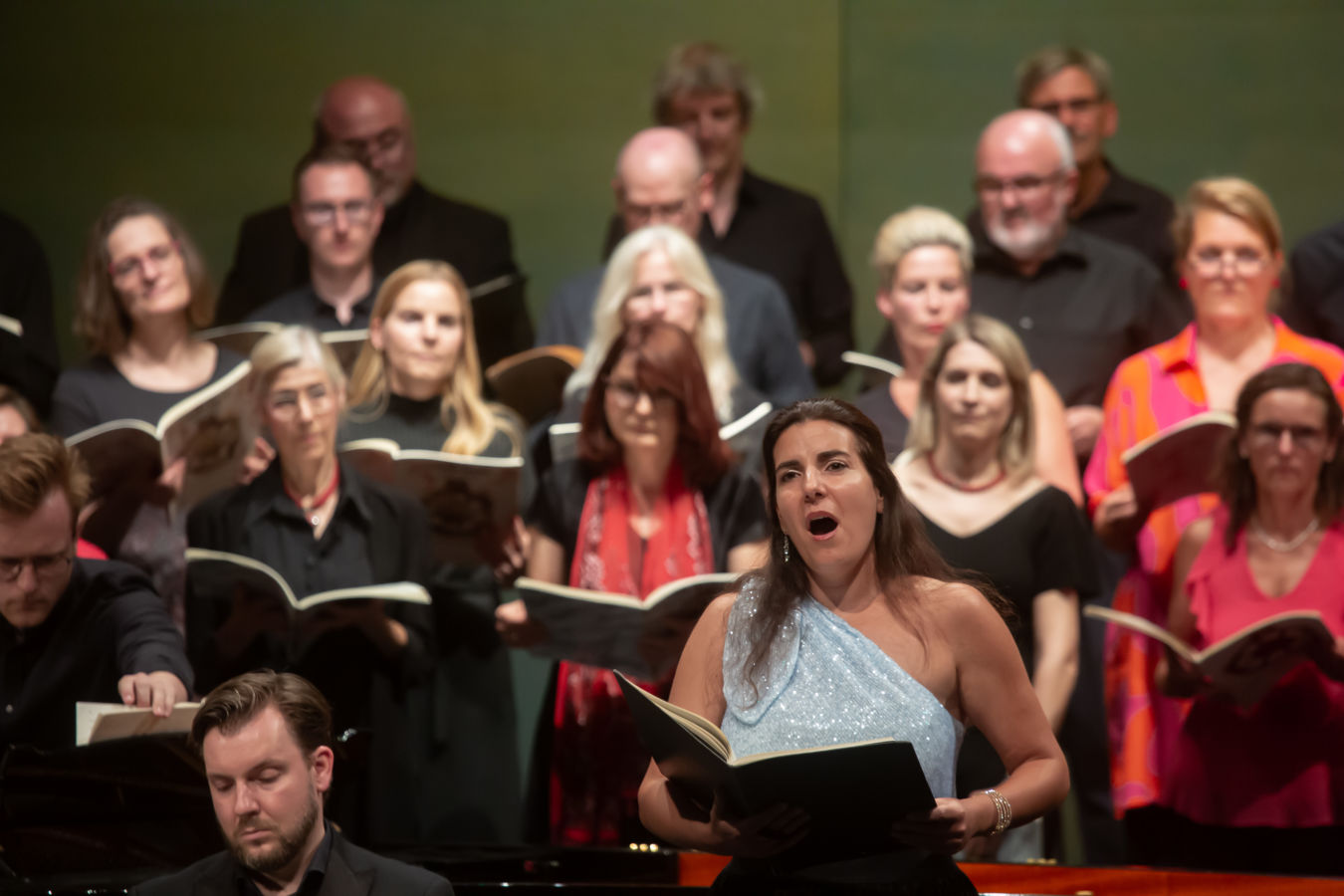In taberna
The second part, In taberna, is set in a medieval tavern where only men meet. Here one learns about „life on the road“, about „gluttony“ or „feasting“, about „gambling“ including the unpleasant consequences and finally about excessive „boozing“ at the tables. With the vagabond confession Estuans interius Orff put a Verdi-like tearjerker at the beginning. Here the baritone Kai Preußker shone with operatic drama, vocal power and huge vocal range. Preußker showed himself to be sovereign and stirring in all aspects – which in turn provoked enthusiastic applause.
To the sighing piano intro, the swan – aka tenor Ivan Yonkov – now entered the stage, shuffling and hanging his head. This effective performance was followed by the ravishingly sung „Swan Aria“ Olim lacus couleram. Parodic in expression and with radiant high C‘ s, the tenor captivated the audience. After each stanza, the male choir also powerfully and confidently threw in its Miser modo niger . This grandiose interpretation of the swan’s lament was also celebrated with enthusiastic applause.
Then again the solo baritone in the double role as the conscienceless dice game cheat Ego sum abbas and the dice game victim Wafna! one right after the other. Vocally and gesturally, this exceptional baritone owed nothing to his role: sometimes in a mocking manner – vigorously mocking his victim, sometimes as an accusing, desperate victim – interrupted by razor-sharp Wafna- interjections from the male chorus – he set another solo highlight on this evening. The highlight of the „Schenke“ part is undoubtedly the final chorus, which Orff described as a „Rossini opera finale chorus of the worst kind.“
With exuberant temperament, razor-sharp text passages, marvellous dynamic effects and effective tempo modifications, the male choir of the Stuttgart ensemble achieved maximum impact. The thoroughly demanding interplay between the male choir and the instrumentalists also left nothing to be desired. Until the whirling stretta and the flung-out Io at the end, the audience listened breathlessly to this impressive performance. Huge applause for the male choir, the soloists and the instrumental ensemble reflected the audience’s enthusiasm at the end of this second part.
Cours d’amours
The third and final part – again atmospherically introduced by the explanatory performance of the speaker Rainer Wolf – now presented the Ragazzi Choir. About 30 pupils of the 5a from the host school had been prepared by music teacher Birgit Pfab. With heart-warming charisma, the boys and girls entered the stage to present their first a cappella performance after a short prelude: Amor volat undique – sung so clearly and brightly that both Orff and the god of love Cupid would have found true joy in it. Together with the children, the solo soprano Fanie Antonelou also entered the stage. In a light, clear-as-a-bell middle voice, she lamented the fate of a woman who has no beloved: Siqua sine socio.
As a „quasi-answer“, then, the baritone’s 3-strophic Dies, nox et omnia in the manner of a medieval troubadour chant. This aria, too, is a real challenge: in the ever-increasing final cadences of this wooing, Orff demands top notes up to b1 – only to call for breakneck changes of register to the low B again. Preußker mastered this vocally challenging task with astonishing ease. And immediately a soprano response: Stetit puella. Effortlessly, Antonelou succeeded in the difficult rise of fifths in the beginning – to then unfold soft melodic lines over the piano ostinato in a touching and haunting way in an intense legato in this rapt aria.
The lyrical moments now give way to a more turbulent musical arrangement. After the baritone’s solo openings in the Circa mea pectora , the three-part male choir takes over the opening motif before the Mandaliet flies back and forth, as it were, in a virtuoso dialogue between female and male choir. Effortlessly clearly articulating, both choral groups succeeded in their entries with pinpoint accuracy. Gestural chord changes and jumping rhythms, but also dynamic changes characterised the highly virtuoso a cappella number of the male choir Si puer cum puellula. Its tempo and precision amazed the audience and elicited spontaneous applause.
Attacca continued with Veni, veni, veni. Temperamentally, this bitonal and six-part double chorus chased along. Once again the solo soprano in an operatic-lyrical aria: in In trutina the fiercely courted woman vacillates between lascivus amor and pudicitia (lustful love and modesty). Fanie Antonelou’s haunting vocalisation left no doubt as to which way the decision would fall… Then, in the famous Tempus est iocundum, the lust for life and love was exuberant. Once again, all participants were musically united: women’s choir, men’s choir and mixed choir virtually overflowed in their spirited and fiery verses – and the famous accelerando of the oh, oh, oh, totus floreo- passage by the ragazzi, the soprano and the baritone set the whole concert hall into vibrating waves.
Sensational the direct connection from the solo soprano in Dulcissime: in this legendary cadenza aria, Orff expresses supreme delights of love, ending in absolute top pitch on d3 and c-sharp3. Fanie Antolenous shone here, flawless and touching at the same time with coloratura soprano skills at the highest level. The chorus then joined in almost hymn-like. The Ave formosissima once again let the full-voiced choir with large orchestral input rise to full bloom. Blanziflor et Helena and Venus generosa became the apotheotic climax of the evening and a declaration of love for life and love. Once again, the goddess of fate reminds us of her power. O Fortuna – a moving conclusion – presented by all participants with the highest emphasis and most intense expression.
Never-ending ovations showed the audience’s emotion and enthusiasm. The legendary final chorus had to be repeated once again. The evening was a great moment for the choir, all participants and the audience: Orff’s work of the century had once again impressively proven its magic.
Image rights: Timo Kabel










